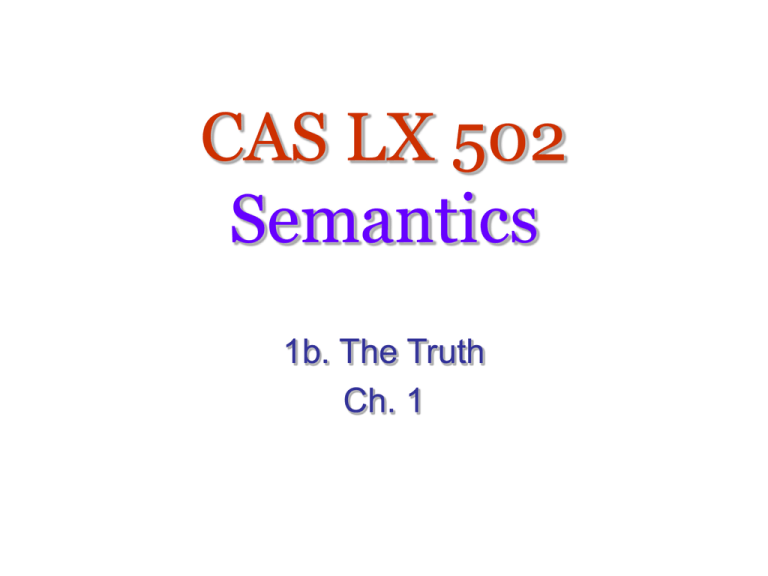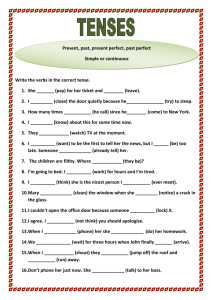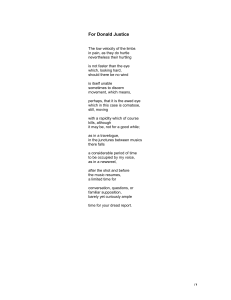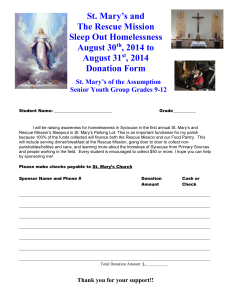PowerPoint
advertisement

CAS LX 502
Semantics
1b. The Truth
Ch. 1
Specifics of meaning
Basic goals initially:
What kind of thing is the meaning of a
sentence?
What kind of thing is the meaning of a word
(or word part)?
How do they relate?
These initial goals will take us through much of the
semester, in some form or another
Meaning?
It’s difficult to pin down anything we
could confidently call meaning.
A sentence might “mean something,”
but what does that tell us?
Where do we start? Images?
Memories? Associations?
The meaning of a (simple)
sentence
Starting point: Homer is standing.
Whatever the meaning is, if we know it,
there’s a trick we can do.
Separating situations
Reduce the problem to an easier one:
Forget trying to decide what the sentence
Homer is standing means.
Concentrate instead on what someone who
knows what Homer is standing means can do.
If we know the meaning of Homer is standing,
we can separate situations into those in which
it is true and those in which it is false. We
know the truth conditions.
Truth conditions
So, whatever meaning of a (simple)
sentence is, it includes the truth
conditions of that sentence.
Perhaps that’s even all meaning is.
Inside every hydrogen atom, there is a
small blue-and-white orb which
continually displays the original
episode of The Twilight Zone.
Sentences vs. propositions
If we’re basing our semantics on a notion of true, false, and
possible worlds, the objects we are investigating are things
that can be true or false in a possible world.
John realized that Mary closed the door and
began to dance.
Mary closed the door.
John realized (something).
John is dancing.
John was not dancing before.
Truth conditions = meaning?
Intuitions about logic.
Mary closed the door.
John danced.
Mary closed the door and John danced.
What is the effect of and?
Truth conditions = meaning?
Intuitions about logic.
Mary closed the door or John danced.
Mary closed the door and John did not dance.
Aside on set theory
A set is a collection of things:
Here, a is a member of the set A, and
improbable is not.
{a, 1, Bill, tomorrow} = A
a {a, 1, Bill, tomorrow}
improbable {a, 1, Bill, tomorrow}
Things are either members of a set or not.
{a, a} = {a}.
Aside on set theory
There are relations we can describe
between sets:
Elements that are in both sets are said to be in the
intersection of the sets. Elements that are in one or
the other are said to be in the union of the sets.
A set A is a subset of a set B if every element in A is
also in B.
{A, B, D, E} {B, D, F} = {B, D}
{A, B, D} {B, F, G} = {A, B, D, F, G}
{A, B} {A, B, C}; {A, B, C} {A, B, C}
A is a proper subset of B if (1) A is a subset of B, and
(2) there is some element in B that is not in A.
{A, B} {A, B, C}; {A, B, C} {A, B, C}
Aside on set theory
If we designate a domain, we can also talk
about the complement of a set.
Domain: {A, B, C, D}
A = {A, C}
A = {B, D}
An element x is in A if (1) it is not in A, (2) under no other
conditions.
An element x is in A if and only if x is not in A.
An element x is in A iff x is not in A.
x A iff x A
x A x A
x A x A
Special sets
We sometimes have cause to talk of a set that
has no members: The empty set.
{} or Ø
Or a set that has exactly one member, a
singleton set.
{Ralph}
Set notation
Set notation is a convenient (and potentially
quite precise) terminology in which to
discuss meanings in terms of possible worlds.
P = the set of worlds in which p is true.
Q = the set of worlds in which q is true.
PQ?
PQ?
P?
We can define “logical connectives” quite
simply, in a way which matches our intuitions
about that they mean.
More on intuitions
When are two propositions
synonymous?
Or contrary/opposite?
The switch is on. The switch is off.
When is a proposition tautological?
The switch is on. The switch is not off.
The switch is on or the switch is off.
When is a proposition contradictory?
The switch is on and the switch is off.
Entailment
This is a red dot.
This is red.
This is a dot.
We believe (intuitively) that if the first one is
true, the second and third are also
necessarily true.
The first one entails the second and third.
And the relation of entailment is easy to state and understand
in the set/world terms we are developing. This is promising…
Thoughts and beliefs
Sets of possible worlds can also model quite
nicely information states.
Suppose I believe that Mary opened the
door.
There are many, many possible worlds.
With respect to Mary opened the door, they
can be divided into two sets.
The actual world is one of the possible
worlds.
My belief is essentially one about which set
of possible worlds contains the actual world.
Thoughts and beliefs
w0 = {w: Mary opened the door in w}
We can divide the worlds in which Mary
opened the door into two subsets with
respect to the proposition John dropped his
pencil.
If all I know is that Mary opened the door,
and someone tells me that John dropped
his pencil (and I believe it), then I have
narrowed the possibilities for where the
actual world is in the space of all possible
worlds.
The games we play
At least a certain type of information
interchange can be thought of as a
game in which the goal is to “find the
actual world” by narrowing down the
places it might be.
The more information you have, the
closer you are to finding the actual
world—the more places you know it
isn’t.
Did Mary open the door?
We can actually get pretty far working
with the machinery so far developed,
but it is worth considering that there
are other kinds of sentences that don’t
immediately lend themselves to an
interpretation directly in terms of truth
conditions.
Is “Did Mary open the door?” true or
false?
Declaratives/interrogatives
We’ve been discussing declaratives,
statements.
An interrogative seems to do something
else, but we can still understand it by
applying the same kinds of analysis.
A declarative divides possible worlds into two
(disjoint) sets. And so does a yes/no question. The
difference seems to be that a declarative is positioning
w0 in one of them, while an interrogative leaves the
position of w0 open—interpreted as a request.
Imperatives
(You) close the door(!).
Also not true and not false. But the fact
that it is imperative seems to be
communicating something like: Make
it come about that w0 is in the true set
of the door is closed.
Conversation
Actual language use can be quite a bit
more complicated, however.
By leveraging the literal meaning of
sentences and using them in certain ways,
we can communicate something different.
In part, this often relies on a mutual
“agreement” between speakers that they
will converse according to certain
conventions, such as:
Do not assert something you know to be false.
Be as informative as possible (within reason).
A distant preview
How many computers do you own?
I own two computers.
I own n computers entails that I own n-1 computers.
I have an actual number k of computers. To say I own k+1
computers would be false.
It is true that I have 2 computers whether I have 2 or more
computers. It’s true that I have 3 computers in fewer
situations. It’s more informative (stronger) to say that I have 3
computers.
Conclusion: I do not own more than two
computers.
But notice this is not part of the literal meaning, it
comes from working out why this was said and not
something else, according to the “rules of the game.”







